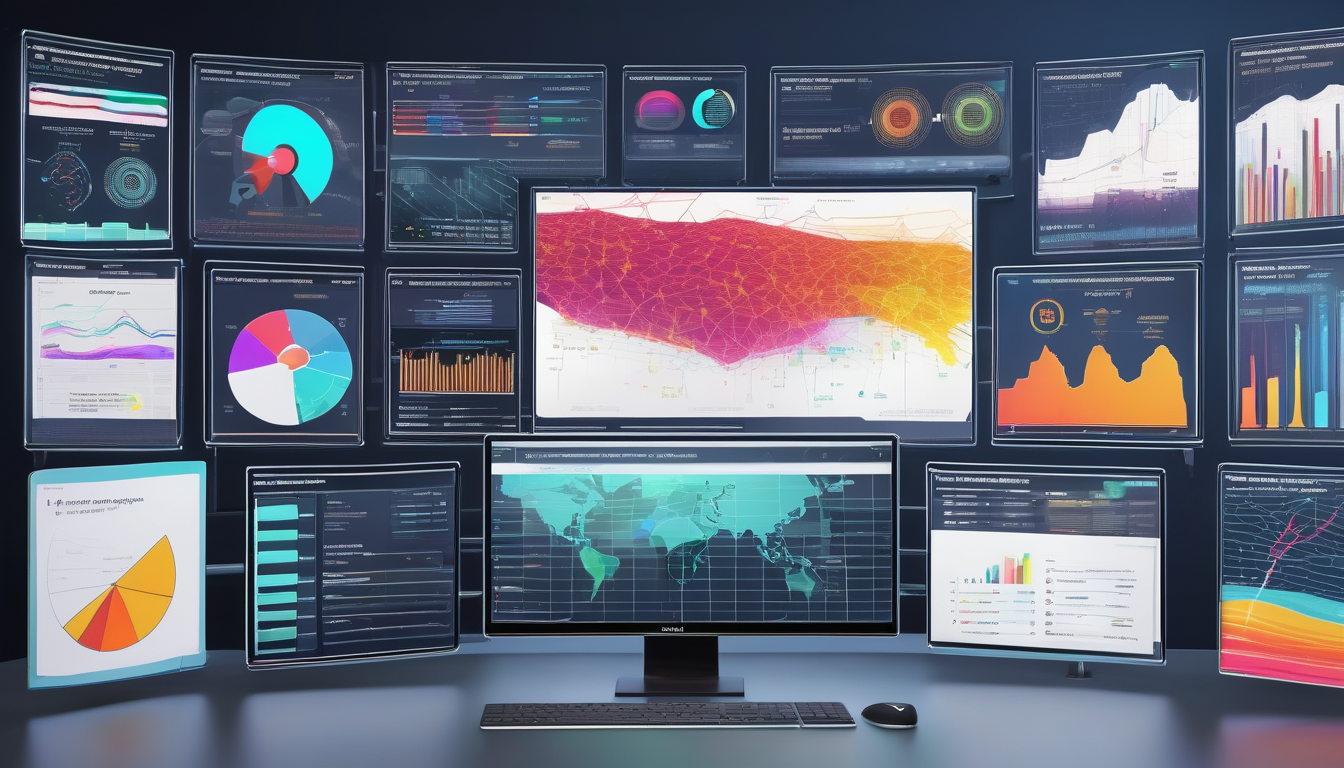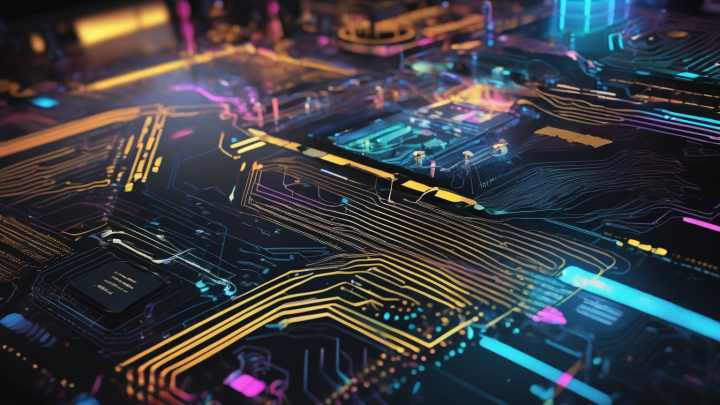In today’s digital age, where every click can lead to a potential cyber threat, the role of artificial intelligence (AI) in enhancing cybersecurity measures has become more crucial than ever. Imagine navigating a vast ocean of data, where every wave represents a potential security breach. AI acts as a lighthouse, guiding organizations through the stormy waters of cyber threats, ensuring they remain safe and secure. This article explores how AI is revolutionizing cybersecurity by improving threat detection, optimizing response times, and strengthening overall security protocols.
Artificial intelligence is not just a buzzword; it’s a powerful tool that plays a pivotal role in modern cybersecurity strategies. At its core, AI encompasses various algorithms and machine learning techniques designed to identify and mitigate cyber threats effectively. By mimicking human cognitive functions, AI systems can process and analyze vast amounts of data at lightning speed, making it easier to spot anomalies that might indicate a breach. This capability allows organizations to stay one step ahead of cybercriminals, turning the tide in the battle for data security.
One of the most significant advantages of AI in cybersecurity is its ability to enhance threat detection. AI algorithms sift through enormous datasets, identifying anomalies that could signify a security breach. Think of it as having a super-sleuth on your team, tirelessly working to uncover hidden threats. Machine learning and pattern recognition are at the forefront of this effort, allowing systems to learn from past incidents and adapt to new threats in real-time.
Machine learning, a subset of AI, empowers systems to learn from data and improve their accuracy over time. This section delves into various machine learning techniques that are instrumental in bolstering cybersecurity. By analyzing historical data, these techniques can identify patterns that may indicate a potential threat, allowing organizations to act swiftly and decisively.
At the heart of effective cybersecurity is anomaly detection. This technique enables AI to identify unusual patterns in network traffic, flagging potential threats before they escalate. Picture it as an early warning system, alerting you to suspicious activity that could compromise your security.
Another key component is behavioral analysis, which leverages AI to understand user behavior and detect deviations from the norm. This is particularly important in identifying insider threats, where an employee’s actions might pose a risk to sensitive data. By monitoring and analyzing user behavior, AI can help prevent data breaches before they occur.
When a security incident occurs, every second counts. AI significantly reduces response times during these critical moments. Automated systems can respond to threats swiftly, minimizing damage and enhancing overall cybersecurity resilience. Imagine having a team of digital defenders that never sleeps, ready to neutralize threats at a moment’s notice.
Vulnerability management is essential for maintaining robust security. AI plays a vital role in this area by assisting organizations in identifying and prioritizing vulnerabilities within their systems. By leveraging AI, companies can ensure timely remediation, keeping their defenses strong against potential attacks.
Predictive analytics, powered by AI, uses historical data to forecast potential vulnerabilities. This proactive approach enables organizations to stay ahead of emerging threats, much like having a crystal ball that reveals future risks. By implementing AI-driven predictive models, businesses can fortify their cybersecurity strategies and protect their valuable assets.
Finally, continuous monitoring is vital for proactive cybersecurity. AI enables real-time monitoring of networks and systems, ensuring immediate detection of threats and vulnerabilities. This constant vigilance is akin to having a security guard watching over your digital assets 24/7, ready to act at the first sign of trouble.

Understanding AI in Cybersecurity
Artificial intelligence (AI) is revolutionizing the way we approach cybersecurity. Imagine a world where technology not only defends against cyber threats but learns and adapts to them in real-time. This is the essence of AI in cybersecurity, where systems can analyze vast amounts of data, recognize patterns, and make informed decisions faster than any human could. By harnessing the power of AI, organizations can enhance their security measures and stay one step ahead of cybercriminals.
At its core, AI in cybersecurity involves several key concepts that are essential for effectively identifying and mitigating threats. First, we have machine learning, a subset of AI that enables systems to learn from data without explicit programming. This means that the more data an AI system processes, the better it becomes at recognizing threats. Additionally, AI utilizes advanced algorithms to sift through enormous datasets, pinpointing anomalies that could indicate a security breach.
Furthermore, AI’s role in cybersecurity extends beyond just detection; it also plays a vital part in response strategies. For instance, when a potential threat is identified, AI can trigger automated responses, minimizing the time it takes to address the issue. This swift action is crucial in preventing damage and ensuring the integrity of sensitive data.
To better understand how AI enhances cybersecurity, consider the following aspects:
- Real-time Analysis: AI systems can analyze network traffic in real-time, allowing for immediate detection of suspicious activities.
- Adaptive Learning: As cyber threats evolve, AI systems learn from new data, adapting their strategies to combat emerging threats effectively.
- Reduced Human Error: By automating many processes, AI minimizes the chances of human error, which is often a significant vulnerability in security protocols.
In summary, AI is not just a tool; it’s a game changer in the realm of cybersecurity. By leveraging its capabilities, organizations can create a more secure environment, ultimately protecting their assets and maintaining trust with their clients.

AI-Powered Threat Detection
In today’s digital landscape, where cyber threats lurk around every corner, has emerged as a game-changer. Imagine having a vigilant guardian that never sleeps, constantly scanning your systems for signs of trouble. That’s the power of artificial intelligence in cybersecurity. By leveraging advanced algorithms, AI can sift through massive amounts of data, identifying anomalies that would take human analysts hours, if not days, to spot.
At the heart of this technology are machine learning and pattern recognition. These AI techniques allow systems to learn from historical data and adapt to new threats in real-time. For instance, consider a scenario where a company experiences a sudden spike in login attempts from unusual locations. An AI system can quickly analyze this behavior and determine if it’s a sign of a potential breach, alerting security teams to take action before any damage occurs.
One of the most effective applications of AI in threat detection is through anomaly detection. This method focuses on identifying deviations from established norms. For example, if a user typically accesses their account from one geographical area and suddenly logs in from a different country, AI can flag this as suspicious. This proactive approach is crucial because it allows organizations to address potential threats before they escalate into full-blown attacks.
Moreover, behavioral analysis plays a pivotal role in enhancing threat detection capabilities. By understanding user behavior, AI can pinpoint insider threats—those sneaky risks that come from within an organization. When an employee’s actions deviate from their usual patterns, AI can trigger alerts, enabling security teams to investigate further. This level of vigilance is essential in preventing data breaches that could compromise sensitive information.
In summary, AI-powered threat detection is revolutionizing the way organizations protect themselves against cyber threats. By harnessing the power of machine learning and behavioral analysis, companies can not only identify potential breaches faster but also respond more effectively, ensuring that their cybersecurity measures remain robust and resilient.
Machine Learning Techniques
In the realm of cybersecurity, machine learning stands out as a transformative force. It allows systems to not just react, but to learn and adapt over time. Imagine a security system that evolves with every new threat it encounters—this is the essence of machine learning in action. By utilizing algorithms that can analyze vast datasets, these systems can identify patterns and anomalies that may indicate a potential security breach.
One of the most effective applications of machine learning in cybersecurity is through supervised learning. In this approach, models are trained on labeled datasets, meaning they learn from examples of both normal and malicious activity. For instance, if a model is fed data that includes both benign network traffic and known attack patterns, it can improve its detection capabilities significantly. This technique is particularly useful for detecting known threats, as it allows for rapid identification and response.
Another powerful technique is unsupervised learning. Unlike supervised learning, this method does not require labeled data. Instead, it identifies patterns on its own, making it invaluable for discovering new types of threats. For example, if a system detects unusual spikes in network traffic that deviate from established norms, it can flag these anomalies for further investigation. This capability is crucial in a landscape where cyber threats are constantly evolving.
Additionally, reinforcement learning is gaining traction in cybersecurity. In this method, algorithms learn through trial and error, receiving feedback based on their actions. This approach enables systems to adapt their strategies in real-time, enhancing their ability to respond to threats dynamically. The combination of these machine learning techniques creates a robust framework for identifying and mitigating cyber threats, ensuring that organizations stay one step ahead of cybercriminals.
In summary, machine learning techniques are revolutionizing the way we approach cybersecurity. By leveraging supervised, unsupervised, and reinforcement learning, organizations can enhance their threat detection and response strategies, ultimately fortifying their defenses against an ever-evolving array of cyber threats.
Anomaly Detection
Anomaly detection is like having a vigilant watchdog for your digital assets. In the vast ocean of data generated every second, it’s easy for potential threats to swim under the radar. This is where artificial intelligence steps in, utilizing sophisticated algorithms to identify unusual patterns that could indicate a security breach. Imagine a security guard who knows the usual faces in a crowd; when a stranger appears, they immediately raise an alarm. Similarly, AI systems are trained to recognize normal behavior and swiftly flag anything that deviates from the norm.
At its core, anomaly detection operates by continuously monitoring network traffic and user behavior. When it detects an activity that stands out, such as a sudden surge in data transfer or an unusual login location, it triggers alerts for further investigation. This proactive approach is essential for organizations that want to stay one step ahead of cybercriminals. In fact, studies have shown that companies employing AI-driven anomaly detection can reduce the time it takes to detect a breach by up to 50%.
Moreover, the effectiveness of anomaly detection can be significantly enhanced when combined with other techniques. For instance, by integrating machine learning with traditional security measures, organizations can create a robust defense system that not only identifies threats but also learns from them. As more data is analyzed, the system becomes increasingly adept at recognizing even the slightest irregularities, ensuring that no potential threat goes unnoticed.
In summary, anomaly detection is a game-changer in the realm of cybersecurity. By harnessing the power of AI, organizations can not only detect threats in real-time but also respond effectively before any damage occurs. This capability is crucial in today’s fast-paced digital landscape, where the cost of a security breach can be astronomical. As we continue to embrace technology, investing in advanced anomaly detection systems will be key to safeguarding our digital futures.
Behavioral Analysis
Behavioral analysis is a game-changer in the realm of cybersecurity. Imagine having a vigilant guardian that constantly observes your network, learning the normal patterns of user behavior. This is precisely what AI-powered behavioral analysis does. By leveraging advanced algorithms, it can detect deviations from established norms, which often signals potential threats lurking within the shadows.
So, how does this work? Picture a typical day in your office: employees log in, access files, and communicate with colleagues. Behavioral analysis creates a baseline of what “normal” looks like. When someone suddenly downloads a massive amount of sensitive data or accesses restricted areas without prior authorization, the system raises a red flag. This proactive approach is crucial for identifying insider threats—those sneaky breaches that can happen from within an organization.
Furthermore, behavioral analysis isn’t just about catching bad actors; it also helps organizations understand their users better. By analyzing patterns, companies can tailor their security measures to fit the unique behaviors of their workforce. This means fewer false positives, which can often lead to alarm fatigue among security teams. In fact, studies show that organizations employing behavioral analysis report a significant reduction in false alerts, allowing teams to focus on genuine threats.
To illustrate the effectiveness of behavioral analysis, consider the following table showcasing its benefits compared to traditional methods:
| Feature | Behavioral Analysis | Traditional Methods |
|---|---|---|
| Threat Detection Speed | Real-time | Delayed |
| False Positives | Low | High |
| User Insights | In-depth | Limited |
In conclusion, behavioral analysis is not just a tool; it’s an essential ally in the fight against cyber threats. By continuously monitoring user activities and adapting to their behaviors, organizations can create a dynamic security environment that not only protects sensitive data but also fosters a culture of safety and awareness among employees. It’s like having a security team that never sleeps, always ready to jump into action at the slightest hint of trouble.
Automated Incident Response
In today’s fast-paced digital landscape, the speed of response during a cybersecurity incident can make or break an organization’s security posture. leverages the power of artificial intelligence to react to threats in real-time, significantly reducing the time it takes to mitigate potential damage. Imagine a firefighter who can instantly identify the source of a blaze and deploy the right extinguishing method without waiting for orders—that’s the essence of automated incident response in cybersecurity.
When a security breach occurs, traditional methods often involve manual intervention, which can be slow and prone to human error. However, AI-powered systems can analyze incoming threats and execute predefined response protocols automatically. This not only minimizes response times but also allows human analysts to focus on more complex issues rather than getting bogged down in routine tasks. The effectiveness of automated incident response can be broken down into a few key components:
- Rapid Detection: AI systems continuously monitor network activity, enabling them to identify anomalies that could signify a breach almost instantly.
- Immediate Action: Once a threat is detected, automated systems can take predefined actions—like isolating affected systems or blocking malicious IP addresses—without waiting for human approval.
- Learning and Adapting: With machine learning algorithms, these systems improve their response strategies over time, learning from past incidents to handle future threats more effectively.
To illustrate the impact of automated incident response, consider the following table, which compares traditional response times versus automated responses:
| Incident Type | Traditional Response Time (minutes) | Automated Response Time (seconds) |
|---|---|---|
| Malware Attack | 15 | 5 |
| Phishing Attempt | 10 | 3 |
| DDoS Attack | 20 | 1 |
As shown, the difference is staggering. Automated systems can respond to threats in a fraction of the time, effectively minimizing the window of opportunity for cybercriminals. In a world where every second counts, embracing automated incident response is not just advantageous; it’s essential for maintaining robust cybersecurity.

AI in Vulnerability Management
In today’s digital landscape, vulnerability management is not just a luxury; it’s a necessity. As organizations face an ever-evolving array of cyber threats, the integration of artificial intelligence (AI) into vulnerability management strategies is proving to be a game-changer. AI helps organizations not only identify vulnerabilities but also prioritize them based on potential impact, ensuring that resources are allocated efficiently.
Imagine trying to find a needle in a haystack. Traditional vulnerability management can feel just like that, with countless vulnerabilities lurking in systems, waiting for the right moment to strike. However, AI streamlines this process by employing advanced algorithms that sift through vast amounts of data, pinpointing vulnerabilities that are most critical. This proactive approach allows organizations to address potential issues before they become significant threats.
One of the most powerful features of AI in vulnerability management is its ability to perform predictive analytics. By analyzing historical data and patterns, AI can forecast potential vulnerabilities that might arise in the future. This foresight is invaluable, as it enables organizations to implement preventive measures rather than merely reacting to incidents. For instance, AI can analyze past breaches to identify common factors, helping organizations to fortify their defenses accordingly.
Moreover, continuous monitoring powered by AI ensures that vulnerabilities are detected in real-time. This means that organizations can maintain a constant watch over their networks, immediately identifying and addressing any potential weaknesses. With AI’s ability to learn and adapt, these systems become increasingly effective over time, evolving alongside the threats they are designed to combat.
In summary, AI’s role in vulnerability management is transforming how organizations protect themselves. By leveraging predictive analytics and continuous monitoring, businesses can stay one step ahead of cyber threats, fostering a culture of security that is proactive rather than reactive. As we continue to embrace AI technologies, the future of cybersecurity looks not only promising but also significantly more secure.
Predictive Analytics
is revolutionizing how organizations approach cybersecurity. By leveraging historical data and advanced algorithms, it allows companies to forecast potential vulnerabilities before they become significant threats. Imagine having a crystal ball that not only reveals the future but also helps you prepare for it. That’s the power of predictive analytics in the realm of cybersecurity!
At its core, predictive analytics involves analyzing patterns and trends from past incidents to identify potential risks. This proactive approach enables organizations to allocate resources effectively and prioritize their security efforts. For instance, if a company notices an uptick in phishing attempts targeting similar businesses, it can bolster its defenses before becoming a victim.
The process typically involves several key steps:
- Data Collection: Gathering data from various sources, including network logs, user behavior, and external threat intelligence.
- Data Analysis: Utilizing machine learning algorithms to sift through the data, identifying trends and patterns that may indicate future vulnerabilities.
- Risk Assessment: Evaluating the potential impact of identified vulnerabilities and prioritizing them based on their threat level.
- Actionable Insights: Providing security teams with recommendations on how to mitigate identified risks effectively.
One of the most exciting aspects of predictive analytics is its ability to adapt and learn over time. As new data is fed into the system, the algorithms improve, becoming more accurate in their predictions. This continuous learning process ensures that organizations stay a step ahead of cybercriminals, making it increasingly difficult for attackers to exploit vulnerabilities.
In conclusion, predictive analytics is not just a trend; it’s a game-changer in the cybersecurity landscape. By harnessing the power of data, organizations can not only anticipate threats but also develop robust strategies to mitigate them, ultimately enhancing their security posture and resilience against cyber attacks.
Continuous Monitoring
In today’s fast-paced digital landscape, has become a linchpin in the fight against cyber threats. Imagine a security guard that never sleeps, always on the lookout for any unusual activity. That’s essentially what AI-driven continuous monitoring does for your network. It provides a real-time overview of your systems, ensuring that any potential threats are spotted before they can cause significant harm.
With the ability to analyze vast amounts of data at lightning speed, AI can detect anomalies that a human might overlook. This is crucial because cyber threats are constantly evolving, and traditional security measures may not be enough to keep up. Continuous monitoring systems utilize advanced algorithms to scrutinize network traffic, user behaviors, and system activities, creating a comprehensive security blanket.
Here’s how continuous monitoring enhances cybersecurity:
- Real-Time Alerts: Automated alerts notify security teams of suspicious activities, allowing for immediate investigation and response.
- Behavioral Baselines: AI establishes normal behavior patterns, making it easier to identify deviations that may indicate a breach.
- 24/7 Surveillance: Unlike human monitors, AI systems operate around the clock, providing constant vigilance without fatigue.
Furthermore, the integration of continuous monitoring with other security measures leads to a more robust defense strategy. By correlating data from various sources, organizations can not only respond to incidents but also anticipate potential vulnerabilities. This proactive stance is essential in a world where cyber threats can emerge from anywhere, at any time.
In conclusion, continuous monitoring powered by AI is not just a trend; it’s a necessity for organizations aiming to safeguard their digital assets. By embracing this technology, businesses can stay one step ahead of cybercriminals, ensuring that their security posture is not only reactive but also proactive.
Frequently Asked Questions
- What is the role of AI in cybersecurity?
AI enhances cybersecurity by automating threat detection, improving response times, and analyzing vast data sets to identify potential risks. It acts like a digital guard dog, sniffing out dangers before they can harm your systems.
- How does AI improve threat detection?
AI improves threat detection through advanced algorithms that analyze network traffic for anomalies. Think of it as a sophisticated radar system that picks up unusual patterns, alerting security teams to potential breaches in real-time.
- What are machine learning techniques used in cybersecurity?
Machine learning techniques include anomaly detection and behavioral analysis. These methods allow systems to learn from data and adapt to new threats, much like how we learn from our experiences to avoid danger.
- How does AI assist in vulnerability management?
AI helps organizations identify and prioritize vulnerabilities by analyzing historical data and predicting potential risks. It’s like having a crystal ball that shows where the next attack might come from, allowing teams to shore up defenses proactively.
- What is automated incident response?
Automated incident response is when AI systems react to security threats without human intervention, significantly reducing response times. Imagine having a fire alarm that not only alerts you but also douses the flames automatically!
- Why is continuous monitoring important in cybersecurity?
Continuous monitoring is crucial because it ensures that threats and vulnerabilities are detected immediately, allowing for swift action. It’s like having security cameras that never blink, always watching for suspicious activity.



